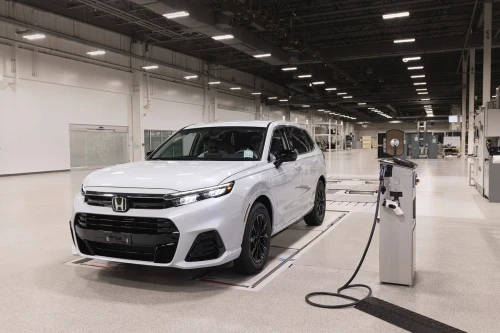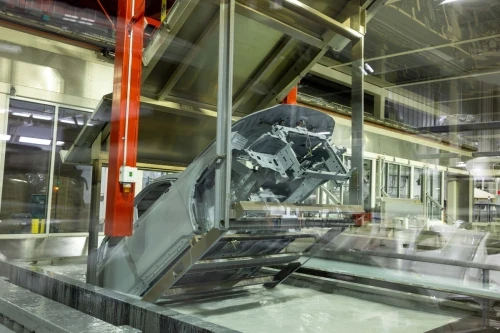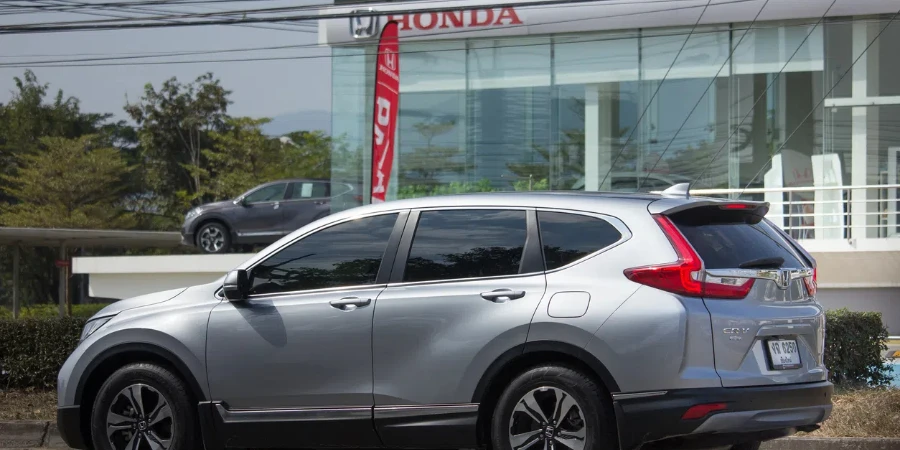Honda started production of the all-new 2025 Honda CR-V e:FCEV fuel cell electric vehicle (FCEV) at the Performance Manufacturing Center (PMC) in Ohio. The all-new CR-V e:FCEV is the only FCEV made in America, as well as the first production hydrogen FCEV in the United States to combine an all-new US-made fuel cell system with plug-in EV charging capability.

The CR-V e:FCEV received a 270-mile EPA driving range rating, combining the fuel cell system with plug-in charging to provide up to 29 miles of EV driving around town with the flexibility of fast hydrogen refueling for longer trips.
In addition to producing the Honda CR-V e:FCEV in America, the next gen fuel cell system that powers it is also made in the US at Fuel Cell System Manufacturing LLC, in Brownstown, Michigan—the joint venture production facility established by Honda and General Motors (GM).
The new fuel cell system was co-developed by Honda and GM, achieving higher efficiency and increased refinement, with durability performance doubled and cost reduced by two-thirds compared to the previous fuel cell system in the Honda Clarity Fuel Cell.
PMC Innovations for CR-V e:FCEV production. Production technicians at PMC navigated several challenges related to new production equipment and processes to effectively transition from building the Acura NSX supercar to the Honda CR-V e:FCEV. Following is a look at several of these key initiatives.
New components: PMC technicians are taking on multiple new assembly processes specific to producing a vehicle powered by both a fuel cell system and a plug-in EV battery, requiring multiple connections for the vehicle’s two power sources and the Power Supply Connector that can provide electrical power for various external devices. These include:
- Sub-assembly of two hydrogen tanks, attaching high pressure piping and other parts and then installing the tanks in the vehicle.
- Compressing hydrogen to 10,000 PSI via a new onsite station used to fill the CR-V e:FCEV hydrogen fuel tanks.
- Installation of the fuel-cell system along with connecting high pressure piping and wiring.
- Sub-assembly and installation of the under-floor battery.
New Weld System: Transitioning to the CR-V e:FCEV required a complete transformation of the Weld Department, from a highly-automated welding system created for an aluminium spaceframe to a multi-material unibody construction.
The previous robotic weld system was removed and replaced with new steel welding robots which were installed with characteristics of a traditional weld system but are unique from mass production plants with a flexible fixture system that rolls around on a track.
PMC technicians also now perform some manual MIG welding to apply welds that are difficult for robots to reach to attach closure parts for the doors, hood and tailgate.
Paint System Modifications: The larger and heavier all-steel body of the CR-V e:FCEV requires a different corrosion protection application process than the smaller, all-aluminium Acura NSX.
The CR-V e:FCEV marks the first application in Honda North America of zirconium to a mixed metal, uni-body, and utilizes the same high-appearance paint coating as the NSX. The E-coat dip tank was designed for the smaller surface area of the NSX spaceframe, not a full frame vehicle like CR-V with more surface area inside. As a result, engineers had to modify the dip tank to enable the CUV body shape to enter at a 38-degree angle, steeper than the 15-degree angle for NSX. More precise control of the E-coat pumps also was required for CR-V, to create higher circulation of the E-coat to cover the surface area inside the frame.

Following e-coating, but prior to application of the final paint finish, sealer is applied to prevent water leaks. The CR-V body is mounted on a rotisserie, but unlike the previous equipment arm used to turn the lighter NSX spaceframe, a more robust arm that can maintain stability of the heavier CR-V steel frame is used to turn the frame on its side. This enables associates to apply sealer manually similar to the application for the NSX.
Production of the FCEV at the PMC also is laying the groundwork for production of battery-electric vehicles at the Honda EV Hub in Ohio from the standpoint of software for the Integrated Power Unit (IPU).
CR-V e:FCEV. The Honda CR-V is America’s best-selling CUV of the past quarter century, and the CR-V e:FCEV builds on that foundation to deliver top class cabin space, cargo capacity and power.
Honda engineers optimized CR-V e:FCEV’s steering and suspension tuning to deliver the same sporty driving experience and class-leading refinement as turbo and hybrid-powered CR-V models. Moreover, the driver can customize the driving experience of the CR-V e:FCEV with selectable drive modes, including EV modes to maximize efficiency and a Sport mode to prioritize acceleration and responsiveness.
Refueling with hydrogen takes about the same time as filling a tank with gasoline. Recharging the Honda CR-V e:FCEV takes just 1.8-hours using a level 2 charger and adds up to 29 miles of battery-powered range for short trips around town.
The Honda CR-V e:FCEV also features the Honda Power Supply Connector, turning the CUV into a clean power source capable of running small home appliances, power tools or camping equipment, as well as charging the new Honda Motocompacto e-scooter.
Honda Hydrogen Business. Honda has identified four core domains for the utilization of its fuel cell system. In addition to fuel cell electric vehicles (FCEV), the Honda hydrogen business strategy includes commercial vehicles, stationary power stations and construction machinery. Honda is engaged in collaboration with other companies in pursuit of these business opportunities.
Honda recently debuted a Class 8 Hydrogen Fuel Cell Truck Concept powered by three Honda fuel cell systems to showcase the start of a new demonstration project aimed at future production of fuel cell-powered products for the North American market.
Honda also began demonstration testing of a stationary fuel cell power station on its Torrance, Calif. campus in March 2023, marking the company’s first step toward future commercialization of zero-emission backup power generation.
Honda also is looking at the application of its fuel cell system to equipment such as excavators and wheel loaders, which account for a large segment of the construction machinery market.
Honda Electrification Strategy. Honda has a vision to make battery-electric and fuel cell electric vehicles represent 100% of its new vehicle sales by 2040. Toward this goal, Honda is establishing its “Honda EV Hub” in Ohio where the company will begin production of EVs in North America.
Honda also recently announced plans to build a comprehensive EV value chain in Canada with an approximate investment of USD$11 billion, to strengthen its EV supply system and capability to prepare for a future increase in EV demand in North America. It is the role of the Honda EV Hub in Ohio to establish the expertise and experience for EV production that will be shared across the Honda production network in North America, including the EV value chain initiative in Canada.
Source from Green Car Congress
Disclaimer: The information set forth above is provided by greencarcongress.com independently of Alibaba.com. Alibaba.com makes no representation and warranties as to the quality and reliability of the seller and products.




